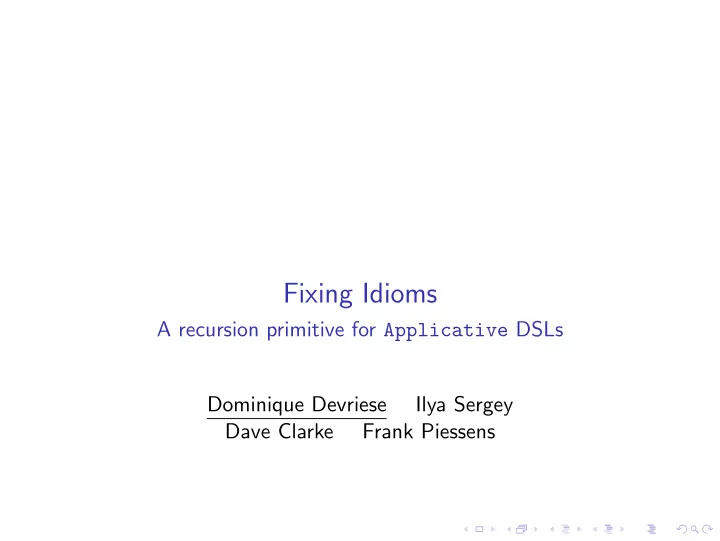

Fixing Idioms A recursion primitive for Applicative DSLs Dominique Devriese Ilya Sergey Dave Clarke Frank Piessens
Functional DSLs ◮ Functional languages are a good host for elegant DSLs ◮ Shallow functional embeddings inherit desirable features: abstraction, types, reasoning. ◮ Missing: a typed, functional representation of cyclic structures? ◮ This problem is holding DSLs back, e.g. parser DSLs: ◮ Why only parse? Why not analyse, visualise, debug? ◮ Less optimisation than parser generators?
Representations of Cyclic Structures ◮ Mutable references, referential identity: imperative � ◮ Deep embeddings: not shallow � ◮ Reduce cyclic to infinite + laziness: ◮ Makes recursion unobservable for DSL algorithms � ◮ In other words: DSL restricted to least fixpoints � ◮ Previous work: ◮ implicitly take fixpoint at top-level (like CFGs) ◮ represent DSL terms as open recursive ◮ no recursion inside term, modularity disadvantages: �
Functional Representations of Cyclic Structures ◮ Add a fixpoint primitive µ x . . . . x . . . to DSL. ◮ Shallow functional representation of binding? HOAS? ◮ Correct version of HOAS: PHOAS or Finally Tagless
Applicative DSLs Applicative DSLs: ◮ good for DSLs representing computations with hidden effects or hidden inputs (e.g. parsers) ◮ contrary to Monad s: still analysable (less power to user, more power to library) ◮ effect-value separation: ◮ Monad : ( > =) :: m a → ( a → m b ) → m b > ◮ Applicative : ( ⊛ ) :: m ( a → b ) → m a → m b ◮ natural setting for effectful recursion (not Monad ic value recursion)
Different fixpoint primitives for different DSLs? ◮ Applicative DSLs differ from lambda calculi (e.g. Oliveira and L¨ oh): ◮ Add pure :: a → p a . ◮ Subtract lam :: ( p a → p b ) → p ( a → b ). Note: adding Lam in an Applicative DSL is not a solution, e.g. parsing. ◮ Observation: finally tagless fixpoint primitive not enough for advanced parser transformations! ◮ Need to specify and exploit value-effects-separation during transformation ! ◮ Surprising: re-specify what already follows?
Contributions ◮ Fixpoint primitive afix : class Applicative p ⇒ ApplicativeFix p where afix :: ( ∀ q . Applicative q ⇒ ( p ◦ q ) a → ( p ◦ q ) a ) → p a ◮ Properties: ◮ Rank-2 type specifies effect-values separation for afix ’s argument ◮ Axiom specifying fixpoint behaviour ◮ Practicality: ◮ Reduce mutual recursion to simple (uses generic programming) ◮ alet -notation: shallow syntactic sugar implemented in GHC ◮ Applications: ◮ Left-recursion removal for Applicative parser combinators ◮ Analyse cyclicity in FRP model of circuits
A Closer Look ◮ Composing Applicative Functors: ( p ◦ q ) ◮ afix ’s type
Composing Applicative Functors class Applicative p where pure :: a → p a ( ⊛ ) :: p ( a → b ) → p a → p b newtype ( p ◦ q ) a = Comp { comp :: p ( q a ) } instance ( Applicative p , Applicative q ) ⇒ Applicative ( p ◦ q ) where ...
afix ’s type class Applicative p ⇒ ApplicativeFix p where afix :: ( ∀ q . Applicative q ⇒ ( p ◦ q ) a → ( p ◦ q ) a ) → p a The type f :: ∀ q . Applicative q ⇒ ( p ◦ q ) a → ( p ◦ q ) a specifies Applicative effects-values separation for f (see paper). Crucial: a restricted equivalent of lambda... coapp :: Applicative p ⇒ ( ∀ q . Applicative q ⇒ ( p ◦ q ) a → ( p ◦ q ) b ) → p ( a → b )
Practicality ◮ nafix : arity-generic version of afix for mutual recursion ◮ alet -notation: shallow syntactic sugar implemented in GHC alet expr = (+) � $ expr ⊂ ∗ token ’+’ ⊛ factor � factor factor = ( ∗ ) � $ factor ⊂ ∗ token ’*’ ⊛ term � term = token ’(’ ∗ ⊃ expr ⊂ ∗ token ’)’ term � decimal in expr Desugars into application of nafix .
Applications ◮ Test circuits for correct cyclicity (see paper). ◮ Left-recursion removal: exprParse :: String → Int exprParse = parseUU ( transformPaull expr ) testParse = exprParse "1+7*3+(8*1+2*6)"
(Intuition behind need for coapp in left-recursion removal) expr :: ... ⇒ p Int expr = afix $ λ s → digit � (+) � $ s ⊛ digit is transformed (essentially) into expr :: ... ⇒ p Int = flip ($) � expr $ digit ⊛ many exprD exprD :: ... ⇒ p ( Int → Int ) exprD = flip (+) � $ digit To derive exprD , we go from type ( ∀ q . Applicative q ⇒ ( p ◦ q ) Int → ( p ◦ q ) Int ) to p ( Int → Int ). This is coapp !
Conclusion ◮ Shallow functional DSLs need shallow functional representation of recursion ◮ Applicative DSLs have special needs ◮ We show one suitable solution with ◮ a new finally tagless primitive afix whose type enforces effects-values separation ◮ support for mutual recursion using generically programmed nafix ◮ shallow syntactic sugar through alet with implementation in GHC ◮ applications to parsing and circuit design ◮ Read our paper if you want to know more!
Recommend
More recommend